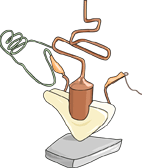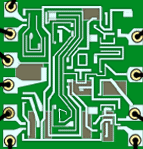|
=
The First
Transistor
In 1947, John Bardeen and Walter Brattain, working at Bell Telephone
Laboratories, were trying to understand the nature of the electrons at the
interface between a metal and a semiconductor. They realized that by
making two point contacts very close to one another, they could make a
three terminal device - the first "point contact" transistor.
They quickly made a few of these transistors and connected them with some
other components to make an audio amplifier. This audio amplifier was
shown to chief executives at Bell Telephone Company, who were very
impressed that it didn't need time to "warm up" (like the heaters in
vacuum tube circuits). They immediately realized the power of this new
technology.
This invention was the spark that ignited a huge research effort in solid
state electronics. Bardeen and Brattain received the Nobel Prize in
Physics, 1956, together with William Shockley, "for their researches on
semiconductors and their discovery of the transistor effect." Shockley had
developed a so-called junction transistor, which was built on thin slices
of different types of semiconductor material pressed together. The
junction transistor was easier to understand theoretically, and could be
manufactured more reliably.
= Transistor Development
For many years, transistors were made as individual electronic components
and were connected to other electronic components (resistors, capacitors,
inductors, diodes, etc.) on boards to make an electronic circuit. They
were much smaller than vacuum tubes and consumed much less power.
Electronic circuits could be made more complex, with more transistors
switching faster than tubes.
However, it did not take long before the limits of this circuit
construction technique were reached. Circuits based on individual
transistors became too large and too difficult to assemble. There were
simply too many electronic components to deal with. The transistor
circuits were faster than vacuum tube circuits, and there were noticeable
problems due to time delays for electric signals to propagate a long
distance in these large circuits. To make the circuits even faster, one
needed to pack the transistors closer and closer together.
=
The Integrated Circuit
In 1958 and 1959, Jack Kilby at Texas Instruments and Robert Noyce at
Fairchild Camera, came up with a solution to the problem of large numbers
of components, and the integrated circuit was developed. Instead of making
transistors one-by-one, several transistors could be made at the same
time, on the same piece of semiconductor. Not only transistors, but other
electric components such as resistors, capacitors and diodes could be made
by the same process with the same materials.
For more than 30 years, since the 1960's, the number of transistors per
unit area has been doubling every 1.5 years. This fantastic progression of
circuit fabrication is known as Moore's law, after Gordon Moore, one of
the early integrated circuit pioneers and founders of Intel Corporation.
The Nobel Prize in Physics 2000 was awarded to Jack Kilby for the
invention of the integrated circuit. This was the start of revolution of
microprocessors and microcontrollers which used in all microcomputers and
most of advanced factories today.
|

Transistor
Inventors

The First Transistor

Integrated Circuit
|